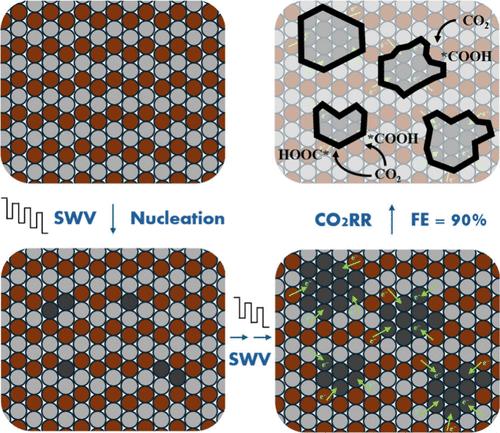Enhanced Zn/ZnO Heterointerfaces via Pulsed-Potential Electrochemical Reconstruction for Highly Selective CO2 Reduction
IF 8.2
2区 材料科学
Q1 MATERIALS SCIENCE, MULTIDISCIPLINARY
引用次数: 0
Abstract
The electrochemical carbon dioxide reduction reaction (CO2RR) demands advanced low-cost cathodes that can overcome the intrinsic scaling limits of single-phase metals. Accordingly, we report a pulsed-potential-based square wave voltammetry (SWV) strategy to reconstruct ZnO nanoparticles into metallic Zn nanoislands embedded on the ZnO wurtzite surface, generating an enhanced density of Zn/ZnO heterointerfaces. TEM/FFT and XPS analyses confirmed more finely discrete metallic Zn domains with a balanced Zn(0)/Zn(II) ratio for the SWV-ZnO electrocatalyst. At these heterojunctions, they preferentially stabilized the *COOH intermediate and weakened *H adsorption, thereby suppressing the competing hydrogen evolution reaction. The SWV-ZnO delivered a peak CO Faradaic efficiency of 90% with a CO partial current density of 5.3 mA/cm2 at −1.05 V versus RHE in the H-cell, outperforming the pristine zinc nanoparticles and the previously reported potentiostatic reconstruction strategies (CA-ZnO). This work demonstrated that pulsed-potential electrochemical reconstruction offered a rapid and scalable route to engineer heterointerfaces, providing a practical blueprint for advancing sustainable CO2-to-CO conversion technologies.

通过脉冲电位电化学重构增强Zn/ZnO异质界面用于高选择性CO2还原
电化学二氧化碳还原反应(CO2RR)需要先进的低成本阴极,可以克服单相金属固有的结垢限制。因此,我们报告了一种基于脉冲电位的方波伏安法(SWV)策略,将ZnO纳米颗粒重建为嵌入在ZnO纤锌矿表面的金属锌纳米岛,从而产生增强的Zn/ZnO异质界面密度。TEM/FFT和XPS分析证实,SWV-ZnO电催化剂具有更精细的离散金属Zn畴,且Zn(0)/Zn(II)比平衡。在这些异质结处,它们优先稳定*COOH中间体,减弱*H吸附,从而抑制竞争性析氢反应。与h电池中的RHE相比,SWV-ZnO在−1.05 V下CO分电流密度为5.3 mA/cm2时,CO的峰值法拉第效率为90%,优于原始锌纳米颗粒和先前报道的恒电位重建策略(CA-ZnO)。这项工作表明,脉冲电位电化学重建为异质界面的工程设计提供了一种快速、可扩展的途径,为推进可持续的二氧化碳到co转换技术提供了实用的蓝图。
本文章由计算机程序翻译,如有差异,请以英文原文为准。
求助全文
约1分钟内获得全文
求助全文
来源期刊

ACS Applied Materials & Interfaces
工程技术-材料科学:综合
CiteScore
16.00
自引率
6.30%
发文量
4978
审稿时长
1.8 months
期刊介绍:
ACS Applied Materials & Interfaces is a leading interdisciplinary journal that brings together chemists, engineers, physicists, and biologists to explore the development and utilization of newly-discovered materials and interfacial processes for specific applications. Our journal has experienced remarkable growth since its establishment in 2009, both in terms of the number of articles published and the impact of the research showcased. We are proud to foster a truly global community, with the majority of published articles originating from outside the United States, reflecting the rapid growth of applied research worldwide.
 求助内容:
求助内容: 应助结果提醒方式:
应助结果提醒方式:


